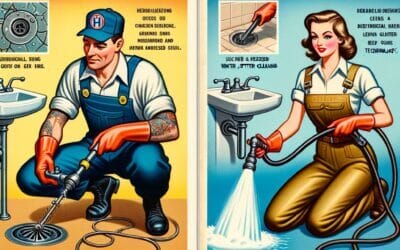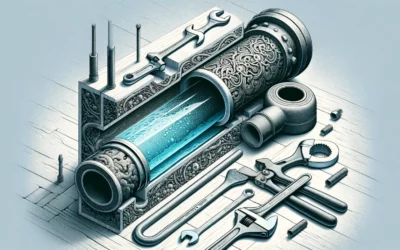Welcome to our comprehensive guide “Expert Solutions: Why Your Toilet Keeps Backing Up and How to Fix It”. This post is designed to educate you on the common reasons why your toilet keeps backing up and provides easy, step-by-step solutions to fix the issue. Derived from expert advice and fact-based analysis, this guide will serve as a practical resource for homeowners and DIY enthusiasts. No longer will you be surprised by a recurring problem, but instead, you’ll have the knowledge to address it head-on and prevent future occurrences. Leave the uncertainty behind, and let’s delve into some useful information that can help maintain the efficiency of your home’s fundamental systems.
Understanding the Problem: Reasons Why Your Toilet Keeps Backing Up
The most common reason why your toilet keeps backing up is due to clogs. Clogs often occur due to the buildup of personal hygiene products, non-flushable items, or a combination of human waste and toilet paper. Flushing items like baby wipes, napkins, and tampons can lead to blockages, as these don’t break down the way toilet paper does. Furthermore, clogs can occur further down the line due to tree roots invading the sewer pipe, causing it to become blocked.
Another common cause is issues with the sewer line. Problems can arise due to a faulty sewer line, such as a broken, blocked, or corroded pipe. Such issues are often indicated by wastewater backing up into other fixtures in your home. Lastly, faults within the plumbing vent can also contribute to toilet backups. The plumbing vent, which removes gas and odors from your plumbing system, can block and cause a pressure imbalance that prevents wastewater from flowing correctly.
- Most common reasons for toilet backup:
- Clogs from non-flushable items
- Tree roots invading the sewer pipe
- Faulty sewer line
- Blocked plumbing vent
| Problem | Solution |
|---|---|
| Non-flushable items | Use a plunger or plumber’s snake |
| Tree roots | Contact professional for removal |
| Faulty sewer line | Inspection and repair by a professional |
| Blocked plumbing vent | Clear the vent manually |
Detailed Diagnosis: Common Symptoms of a Clogged Toilet
When it comes to diagnosing a clogged toilet, there are a few common symptoms you should be on the lookout for. Understanding these signs can be instrumental in identifying and resolving the issue promptly to avoid further damage. The first symptom you might notice is water rising higher than usual when you flush, which can often be interpreted as the start of a backup. If the water does not recede after your flush, this is often a clear sign of a clog. Another potential sign is if your toilet makes a gurgling sound when you flush or has a bubbling effect, which is usually due to air being trapped in the pipes due to a blockage.
| Symptoms | Description |
|---|---|
| Water rising unusually high | When flushed, the water in the toilet bowl rises higher than usual before receding. |
| Gurgling sound or bubbling effect | Auditory disruptions when flushing such as unusual sounds or air bubbles surfacing. |
It’s also worth noting that slow draining is another key indicator which should not be ignored. If the water takes a longer time than usual to drain after flushing, it’s another strong sign that there could be a block in your toilet pipe. Moreover, if you notice a distinct and unpleasant odor, it could indicate a severe clog. In more severe cases, you might also experience sewer waste backup in your toilet or elsewhere in your home.
- Slow draining: Water in the toilet bowl slowly recedes after flushing.
- Unpleasant odor: A distinct smell coming from the toilet, indicating a severe clog.
- Sewage backup: Sewage waste flowing back into the toilet or even into bathtubs and showers.
Remember, early identification of these symptoms can potentially save you from extensive and costly repairs. If you notice any of these signs, it’s advised to address it promptly or seek help from a plumbing professional to quickly rectify.
Expert Insights: What the Regular Backups in Your Toilet Signify
Let’s get real here : Toilet backups are one of the most unpleasant troubles we face at home. Far from being just an inconvenience, they can signal some serious underlying issues that need prompt attention. Toilets can back up for a variety of reasons: ranging from simple issues like excessive toilet paper or non-flushable items in the line, to more complex ones like problems in the main sewer line. A better understanding of these common issues can provide you with the insights needed to prevent and tackle toilet backups effectively.
- Excessive Toilet Paper: This is a common cause. Our love for cleanliness can sometimes cause unwanted obstructions. Remedy? Use smaller amounts and opt for easily soluble alternatives.
- Non-Flushable Items: Not everything is meant to be flushed down the toilet. Use dustbins for disposing of items like wipes, cotton balls, sanitary products, etc.
- Tree Roots & Mainline Issues: This is a critical problem that may need professional help. Tree roots can infiltrate the sewer line and create persistent backups. Mainline issues can also cause backups in all home fixtures, not just the toilet.
If you’ve dealt with the minor issues and still face recurrent backups, you may have a more complicated issue at hand. Partial or complete line blockages, collapsed or bellied pipes, main sewer line issues, etc., could be the underlying problem. Wihtout immediate intervention, these could escalate your problems and even cause water damage. With the more complex issues, we recommend seeking professional help.
| Underlying Issues | Solutions |
|---|---|
| Partial Blockages | Snake the line to remove obstruction |
| Complete Line Blockage | Camera inspection and hydro jetting |
| Collapsed/Bellied Pipes | Replace section of pipe or entire line |
| Main Sewer Line Issues | More intensive remedies like trenchless sewer line repair |
Effective Solutions: How to Effectively Fix Your Blocked Toilet
Toilet blockages can be a troublesome issue, often leading to unpleasant and unsanitary conditions. Thankfully, there are a few reliable methods that can efficiently and effectively resolve this issue. Plunging and auguring are two practical techniques you can employ. Using a plunger is typically the first step in unclogging a toilet; make sure you have a proper toilet plunger (instead of a sink plunger) for effective results. If your attempts with the plunger don’t work, the next tool to reach for is a toilet auger. This device can break up the obstruction or retrieve it so you can remove it from the toilet. However, if you continually experience toilet blockages, there might be root issues that could be causing the problem. For instance, problems might stem from usage, type of toilet paper, or deeper plumbing issues. Some toilets, particularly low-flow models, don’t have sufficient power to clear the drain pipe, which could cause repeated clogs. Even your choice of toilet paper could result in clogs if it’s too thick and doesn’t break down quickly. Another particularly troublesome rooting issue could be an underlying problem with your plumbing system — like a blockage further down the system, a sagging sewer line, or even tree roots invading your pipes. If you’re facing such issues, it might be helpful to list down the potential causes and knock them down one by one. An example of such a table could be:
| Potential Cause | Solution |
|---|---|
| Improper Use | Only flush appropriate waste and toilet paper |
| Unsuitable Toilet Paper | Use easily-degradable toilet paper |
| Deeper Plumbing Issues | Consult with a professional plumber |
Keep in mind that while some issues can be fixed DIY, others might require a professional plumber’s intervention. Don’t be hesitant about calling in professionals when needed; after all, it’s better to address the problem sooner rather than later.
Think Prevention: Tips to Avoid Future Toilet Backups
Let’s accept it, a backed-up toilet is something no homeowner would ever want to deal with. However, with a proactive approach and by gaining some handy insights, you can dramatically reduce the chances of facing this messy problem. It’s all about understanding why toilet clogs occur and what precautionary steps you can take to prevent them.
Regular maintenance: The first line of defense is a regular maintenance schedule. Ensure that your toilet and sewage pipes are cleaned and inspected on a regular basis. This will catch any potential problems in advance and can prevent a total blockage.
- Be mindful of what you flush: Avoid disposal of non-dissolvable items like diapers, wipes, feminine hygiene products, or heavy papers into the toilet. Stick to toilet papers that break down easily.
- Install a sewer backwater valve: This device allows sewer water to flow out of your home and restricts it from flowing back in. A great tool to prevent sewer backups.
- Go for high-efficiency toilets: Newer models of toilets are designed to use less water, thus reducing the risk of clogs and overflows.
With these easy-to-follow tips, you can stay a step ahead and avoid the hassle of frequent toilet backups. It’s not just about saving yourself from a day’s ruin, but also about maintaining the longevity and performance of your plumbing system.

Getting Professional Help: When to Bring in a Plumbing Expert
After attempting to fix your constantly backing up toilet and still encountering challenges, it’s beneficial to consider professional help. With their extensive experience and in-depth knowledge, plumbing experts can diagnose the cause of the issue accurately, provide the proper treatment, and prevent future recurrences. Using advanced tools and techniques, they can assess not just the toilet, but the entire plumbing system to address any underlying problems. Benefits of Hiring a Plumbing Expert:
- Speedy Resolution: A professional can identify and fix the problem faster than an inexperienced person.
- Vast Knowledge Base: They know the ins and outs of different toilet systems and can speak to any unusual problems.
- Reliable and Effective Tools: Professionals use top-of-the-range equipment that most homeowners lack.
- Preventive Maintenance: They can offer advice on how to avoid future plumbing issues, saving you money and inconvenience.
Here is a simple table to guide you on when to call a professional.
| Condition | Action |
|---|---|
| Multiple Toilets Backing Up | Contact a professional. This could indicate a serious problem with the main sewer line. |
| Frequent Toilet Clogs | Call a trained plumber if you’re experiencing persistent clogs, even after attempting fixes. |
| Foul Smell Emitting from the Toilet | Immediately get a plumbing expert. The smell could be due to a sewage backup, which poses health risks. |
Choosing to involve a plumbing expert could be the difference between a smooth, functioning toilet and a pile-up of costly repairs. Don’t wait until the situation becomes unbearable; seek professional assistance promptly to maintain a healthy plumbing system.
In Retrospect
In conclusion, persistent issues with a backed-up toilet can be a source of great inconvenience. However, understanding the causes and proactive solutions might just help you keep the plumber’s number out of your speed dial. Undoubtedly, some toilet blockages necessitate professional help, but many can be handled by a savvy homeowner with a plunger, a little know-how, and a good deal of determination. The expert solutions outlined in this article should serve as a guide in your quest to fix a backing up toilet and prevent future occurrences. Remember, knowledge is power and identifying the possible causes is half the battle. The subsequent half deals with implementing the appropriate fixes. As you have read, the reasons for a backing up toilet range from simple paper clogs, water pressure, to more intricate issues involving sewer lines and septic tank malfunctions. In event of severe blockages or concerns of compromised pipes and sewer systems, it is absolutely vital that you call a reputable plumber to prevent further damages. With some vigilance, care and applying these expert solutions, may the flow be ever in your favor. We hope you found this article informative and helpful! Until next time, we wish you a hassle-free and pleasant experience in maintaining your home’s plumbing system.







